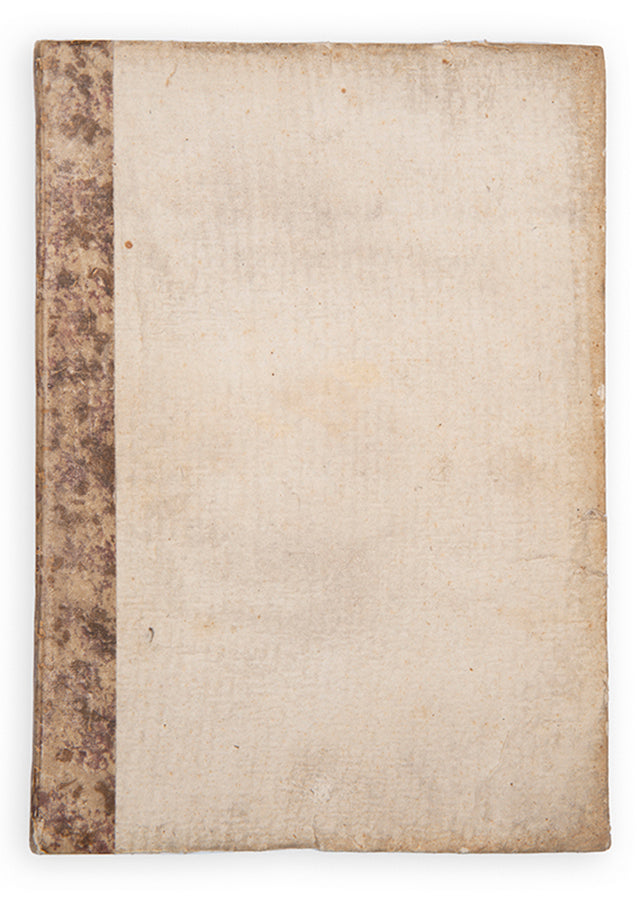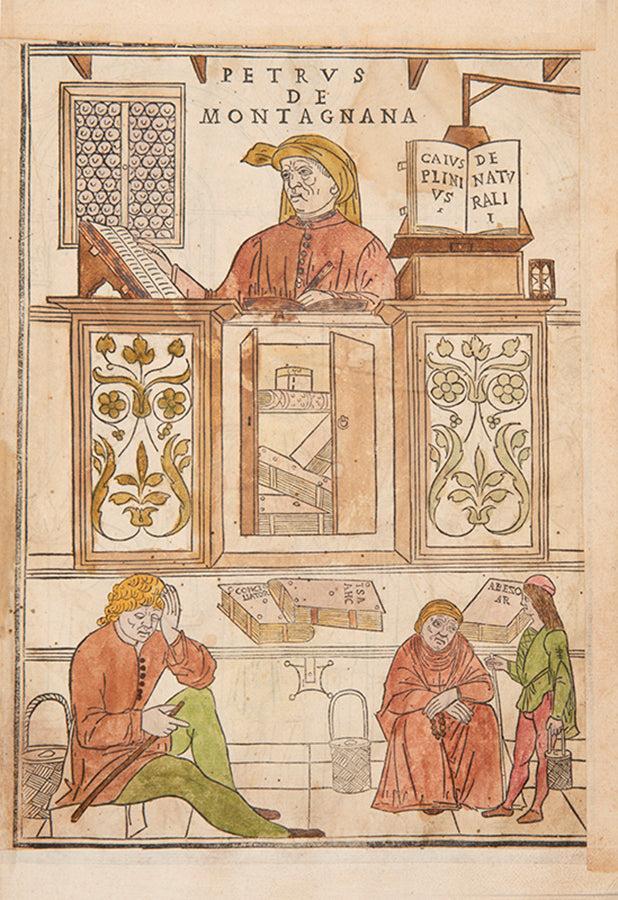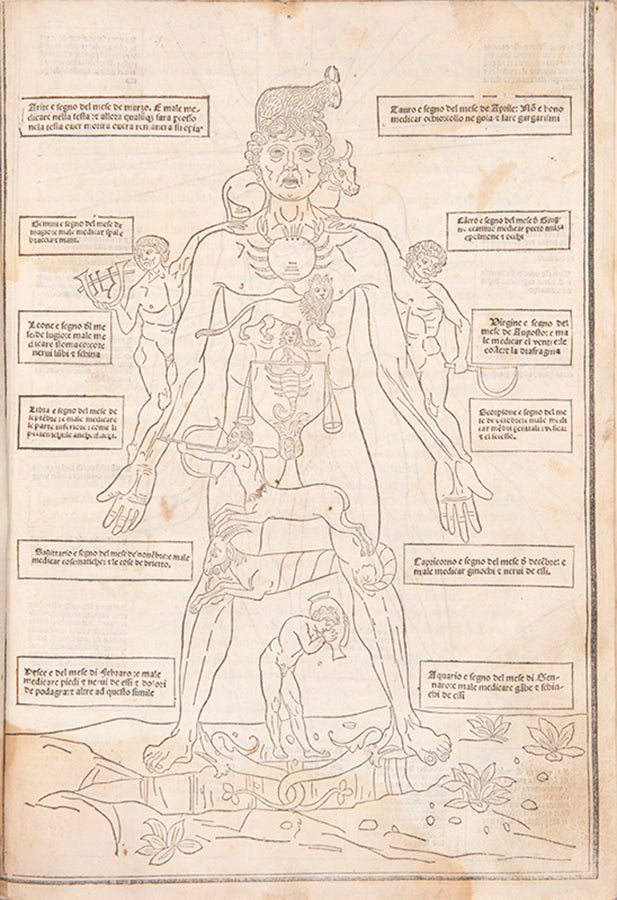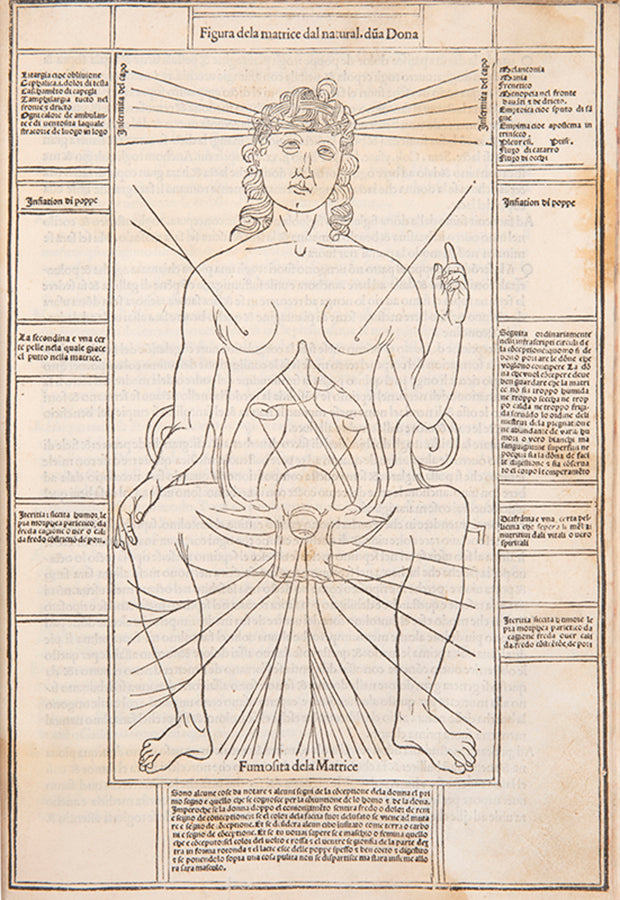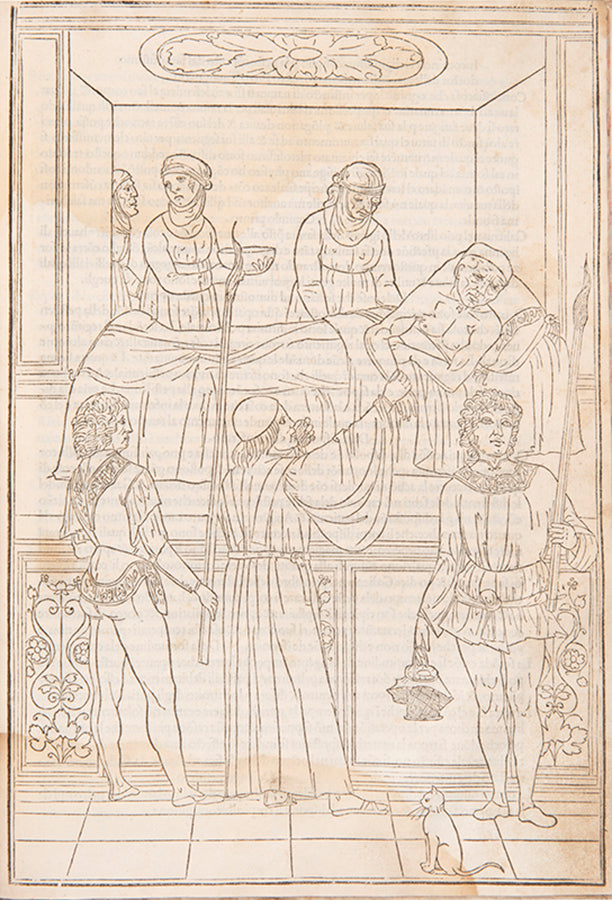KETHAM, Johannes de.
Stock Code 115629
Venice, Joannes & Gregorius de Gregoriis, February 5th, 1493.
the first printed book with anatomical illustrations, with the rare colour-printed plate
First Italian language edition and second overall of the Fasciculus medicinae; the most desirable edition, being the first to include the 'strikingly beautiful' and modern suite of illustrations of the Bellini school (Norman, One Hundred Books Famous in Medicine 10). With the rare colour-printed 'Lesson in dissection' plate that is 'one of the first and finest representations of this operation to appear in any book and furthermore, is one of the first three known examples of colour printing' (Printing and the Mind of Man 36). This edition was also the first to include Mondino de' Luzzi's Anatomia, 'a fourteenth-century compendium by a professor of medicine at Bologna that included observations based on the dissection of human cadavers' (Norman). The new illustrations and focus on dissection make this a primary document in the shift away from classical knowledge and toward observation, experiment, and professionalised education and care. It has been described as 'the first modern medical book imbued with the humanist spirit' (PMM).Originally a collection of medieval medical tracts that circulated in manuscript form, the Fasciculus medicinae became the first printed book with anatomical illustrations when it was published in 1491. But it was this second edition, translated into Italian by Sebastianus Manilius and published by the same Venetian printers, that reflected the changing medical landscape and profoundly influenced the anatomical illustration to come.
'The typography and artistic qualities of this edition of the Fasciculus make it of interest far beyond the world of medicine. It was the first printed medical book to be illustrated with a series of realistic figures' (Norman 10). 'For this Italian edition, all but one of the illustrations were redrawn and four new outline wood-engravings added, showing scenes of medical practice in fifteenth-century Venice. The dramatically improved and more realistic illustrations, which were reproduced in the numerous later editions' are 'evidence of the transition from medieval to modern anatomical illustration' (Jeremy Norman's History of Information).
The illustrations based on medieval precursors include a Zodiac man, bloodletting man, planet man, and a pregnant woman. The four new illustrations devised for this edition are: a doctor identified as 'Petrus de Montagnana' in his study (frontispiece); Petrus, his students, and an attendant with a flask of urine; a doctor's visit to a plague patient; and a lesson in dissection. Historian Arthur M. Hind 'states that "Lesson in dissection", which prefaces Mondino's Anatomio, is sometimes found "printed from three-colour blocks in red, green, and yellow, in addition to the outline in black", the colour probably applied by hand-held blocks rather than the printing press. Others, including Harvey Cushing, have speculated that the colouring in these examples may have been applied using a stencil. Colouring in the other plates, when it occurs, was added by hand' (Norman 10).
The texts that comprise the Fasciculus include sections on surgery, epidemiology, uroscopy, pregnancy and the diseases of women, herbal and other remedies, etc.' (PMM). 'The "Ketham" to whom the printers attributed the collection was probably Johann von Kircheim, a physician and professor of medicine in Vienna who is supposed to have assembled these practical texts and diagrams for educational purposes' (Norman 10).
Rare, with only two complete examples appearing in recent auction records, the present copy (Sotheby's 2006) and the Otto Schafer copy (Sotheby's 1994). WorldCat locates institutional examples at Yale and the Morgan Library, and there is also one at the Metropolitan Museum of Art that includes the colour printed plate.
First Italian language edition, second overall; chancery folio (310 x 206 mm); 52 leaves, 48 lines, roman letter, 6- and 8-line initial spaces with printed guides, woodcut illustrations (9 full-page), some with contemporary hand-colouring, that on f2v printed in 4 colours, first two leaves and a6 repaired with paper in margin, with loss of the top edge of the title image (most of the shelf of books above the lector's head), small hole in a2 affecting a few words, several leaves repaired in gutter, dampstain affecting the lower margin and gutter throughout, smaller and lighter dampstain affecting the upper gutter and portions of text, some contemporary annotations and pen trials and other scattered marks and staining; rembotage using later stiff pressed paper, binding rubbed with some small worn spots and short closed tears.
PMM 36; cf. Garrison & Morton (A Medical Bibliography) 363 (first edition); Norman (One Hundred Books Famous in Medicine) 10; cf. Norman Library of Science & Medicine 1211 (third edition).
Couldn't load pickup availability
About us
About us
Shapero Rare Books is an internationally renowned dealer in antiquarian & rare books and works on paper.
Our Bookshop and Gallery can be found in the heart of Mayfair at 94 New Bond Street, where most of our stock is available to view and on public display.
We exhibit at major international art fairs, including TEFAF (Maastricht and New York), Frieze Masters, Art Miami and Masterpiece London, as well as antiquarian & rare book fairs including New York, Paris, London, Los Angeles, San Francisco and Hong Kong.




